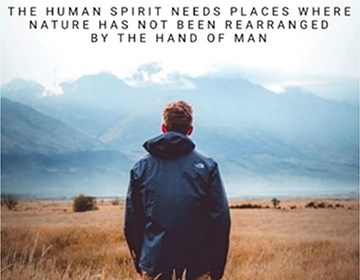Contemplative men in nature – what ecofascism looks like in social media

“A softer image of ecofascism has the potential to contribute to a quieter radicalisation,” says Maria Darwish.
Men at peace in beautiful nature settings. The images on the platform Telegram are posted by men expressing support for ecofascism.
“It’s a representation of far-right masculinity that is not aggressive,” says Maria Darwish, researcher in gender studies, who has analysed close to 300 pictures tagged with ‘ecofascism’.
Together with Lucas Gottzén, Stockholm University, Maria Darwish has identified images on the social media platform Telegram that tie in with “the Nordic aesthetic” and ecofascism, and where the men in the pictures are not openly conveying hate, glorifying violence, or posing with weapons.
“It’s an ecofascist visual communication that uses positive sentiments to depict a nationalist view of nature and masculinity,” says Maria Darwish.
She labels the men in the images on Telegram as “contemplative”, in other words, reflective and spiritual. One example is a picture of a man who has made a campfire in the woods to cook and prepare coffee. Overlooking a seemingly unspoilt landscape, in a soft evening light, he is enjoying the beauty in solitude. Oftentimes, the imagery is the same as in outdoorsy advertisements.

The idealisation of pristine nature is a tradition within fascism. Maria Darwish gives the example of Männerbund, a notion of ancient Germanic rites of masculinity that was revived in 20th century Germany and cultivated within Nazism.
In the images analysed by Maria Darwish, the far-right message is not all that evident, even though many include fascist symbols, such as the othala rune.
She points out that this form of masculinity is based on an emotional bond between white Nordic men and the land, reinforcing ideas of “blood and soil”. Rather than expressing aggression or violence, these men are presented as calm and rooted in a mythical, natural Nordic history.
Maria Darwish’s conclusion is that this type of visual narrative can attract young men to far-right extremism.
“It’s not just about ideology or violence, but also about community, warmth, and a sense of security. That way, a softer image of ecofascism has the potential to contribute to a quieter radicalisation,” she says.
Ecofascism combines extreme nationalism with environmentalism and a resistance to modern society. Certain groups of people are viewed as a threat to both the environment and the survival of the nation.
Ecofascism uses protection of the environment to justify exclusion, racism, and violence.
Ecofascism often has authoritarian elements but can manifest itself in many ways without a fully authoritarian state.
Text: Maria Elisson
Photo: Maria Elisson
Translation: Charlotta Hambre-Knight
